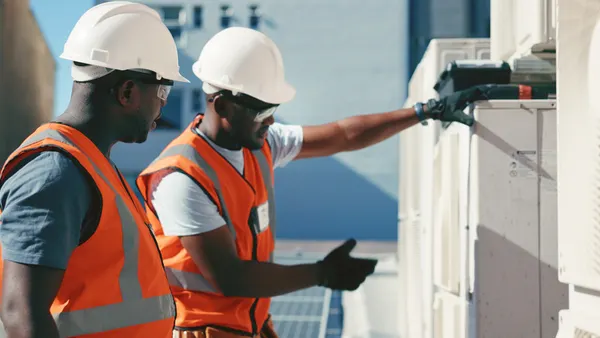Bank of America will offer virtual reality training to employees nationwide via its career training program, The Academy, a spokesperson told HR Dive in an email this month.
The Academy supports some 50,000 Bank of America employees across 4,000 of the company's U.S. financial centers. The bank tapped immersive learning company Strivr, known for its work bringing VR headsets to Walmart stores in recent years.
Bank of America is using Strivr's solution to train for several functions, from simulators that help workers train on the bank's account opening and servicing systems to AI-powered tools that allow workers to practice having conversations with clients, John Jordan, head of The Academy, said during a recent webinar. VR is also being used to upskill the bank's employees and help them move to different functions more quickly.
The bank received a crash course in upskilling last year as workers pivoted to implement the requirements of the Paycheck Protection Program. "We did 17 years worth of business loans in 60 days," Jordan said, which required reskilling some 20,000 employees. "What that showed us was the art of the possible … if we can move 20,000 people in the blink of an eye practically to do something different, then we need to be thinking about that more proactively on a daily basis."
Jordan also emphasized the importance of VR in training employees to serve clients empathetically and professionally during sensitive transactions, such as buying a home. "It gives us the ability to really practice the moments of truth with clients, those moments where there's a lot of emotion [and] potentially tension," he said.
Certification and performance monitoring are also key. "It's not just about the individual in the goggles, it's about the coach watching the individual in the goggles," Jordan said. Bank of America already had a coaching program in place that ensures high-performing individuals in every role have the opportunity to teach others, he added.
The Academy supports more than 220 job types and originally piloted VR with some 400 individuals across multiple geographies and job functions. The company relies partly on managers to establish a constant rhythm of training for each employee, but managers do not always have the bandwidth to ensure this. "We've got to make sure that we're able to provide high-quality practice reps no matter where you're sitting," Jordan said.
Bank of America also surveys employees as they go through training, which can evaluate in real-time their grasp of training material, Jordan noted. This allows for incremental improvements on learning tech on a month-by-month basis.
VR's impact on productivity has proved effective in earning buy-in from leadership on the tech because it shortened processes that might otherwise take several weeks to complete, Jordan said, but there are other potential benefits. "Years from now, everyone's going to have some sort of VR or AR in their life," he noted. "In the vein of innovation, we know that we're opening up a whole new set of options for engaging our employees and helping them be better at their jobs."
But there are also "invisible costs" that VR can help demonstrate as workers move away from traditional click-through training. Jordan said that when Bank of America began to make the switch to experiential learning for one particular process, it noticed a "high fail rate," which in turn created another type of business case for VR — that it could help address the cost of errors.
As helpful as the tech has been in improving training efficiency, Jordan said he does not envision that VR will replace all training types; "I never see a day when I say, all of your learning is in virtual reality. I think you could see a day when everyone has a piece of their learning which is done in virtual reality."
Correction: An earlier version of this story misspelled Strivr's name and incorrectly described its offering.













